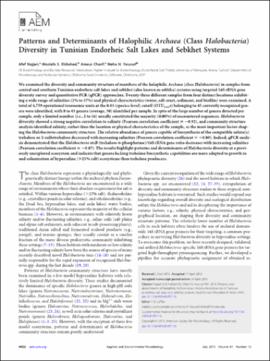| dc.contributor.author | Najjari, Afef | |
| dc.contributor.author | Elshahed, Mostafa S. | |
| dc.contributor.author | Cherif, Ameur | |
| dc.contributor.author | Youssef, Noha H. | |
| dc.date.accessioned | 2018-09-21T17:51:29Z | |
| dc.date.available | 2018-09-21T17:51:29Z | |
| dc.date.issued | 2015-07 | |
| dc.identifier | oksd_najjari_patternsanddete_2015 | |
| dc.identifier.citation | Najjari, A., Elshahed, M. S., Cherif, A., & Youssef, N. H. (2015). Patterns and determinants of halophilic Archaea (class Halobacteria) diversity in Tunisian endorheic salt lakes and sebkhet systems. Applied and Environmental Microbiology, 81(13), 4432-4441. https://doi.org/10.1128/AEM.01097-15 | |
| dc.identifier.uri | https://hdl.handle.net/11244/301752 | |
| dc.description.abstract | We examined the diversity and community structure of members of the halophilic Archaea (class Halobacteria) in samples from central and southern Tunisian endorheic salt lakes and sebkhet (also known as sebkha) systems using targeted 16S rRNA gene diversity survey and quantitative PCR (qPCR) approaches. Twenty-three different samples from four distinct locations exhibiting a wide range of salinities (2% to 37%) and physical characteristics (water, salt crust, sediment, and biofilm) were examined. A total of 4,759 operational taxonomic units at the 0.03 (species-level) cutoff (OTU0.03s) belonging to 45 currently recognized genera were identified, with 8 to 43 genera (average, 30) identified per sample. In spite of the large number of genera detected per sample, only a limited number (i.e., 2 to 16) usually constituted the majority (>/=80%) of encountered sequences. Halobacteria diversity showed a strong negative correlation to salinity (Pearson correlation coefficient = -0.92), and community structure analysis identified salinity, rather than the location or physical characteristics of the sample, as the most important factor shaping the Halobacteria community structure. The relative abundance of genera capable of biosynthesis of the compatible solute(s) trehalose or 2-sulfotrehalose decreased with increasing salinities (Pearson correlation coefficient = -0.80). Indeed, qPCR analysis demonstrated that the Halobacteria otsB (trehalose-6-phosphatase)/16S rRNA gene ratio decreases with increasing salinities (Pearson correlation coefficient = -0.87). The results highlight patterns and determinants of Halobacteria diversity at a previously unexplored ecosystem and indicate that genera lacking trehalose biosynthetic capabilities are more adapted to growth in and colonization of hypersaline (>25% salt) ecosystems than trehalose producers. | |
| dc.format | application/pdf | |
| dc.language | en_US | |
| dc.publisher | American Society for Microbiology | |
| dc.rights | This material has been previously published. In the Oklahoma State University Library's institutional repository this version is made available through the open access principles and the terms of agreement/consent between the author(s) and the publisher. The permission policy on the use, reproduction or distribution of the material falls under fair use for educational, scholarship, and research purposes. Contact Digital Resources and Discovery Services at lib-dls@okstate.edu or 405-744-9161 for further information. | |
| dc.title | Patterns and determinants of halophilic Archaea (class Halobacteria) diversity in Tunisian endorheic salt lakes and sebkhet systems | |
| osu.filename | oksd_najjari_patternsanddete_2015.pdf | |
| dc.description.peerreview | Peer reviewed | |
| dc.identifier.doi | 10.1128/AEM.01097-15 | |
| dc.description.department | Microbiology and Molecular Genetics | |
| dc.type.genre | Article | |
| dc.type.material | Text | |
| dc.subject.keywords | biodiversity | |
| dc.subject.keywords | dna, archaeal | |
| dc.subject.keywords | dna, ribosomal | |
| dc.subject.keywords | halobacteriales | |
| dc.subject.keywords | lakes | |
| dc.subject.keywords | tunisia | |
